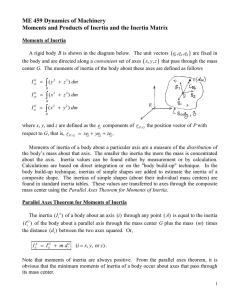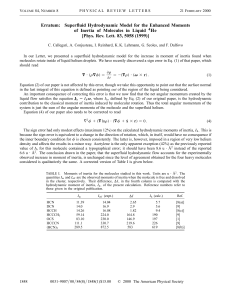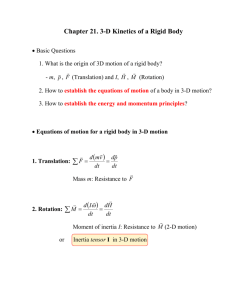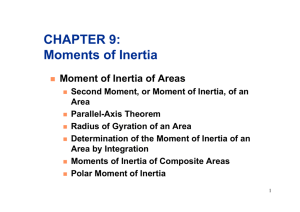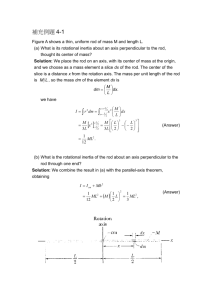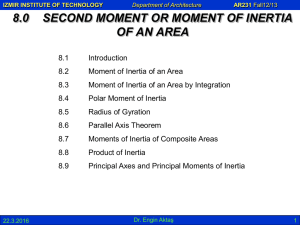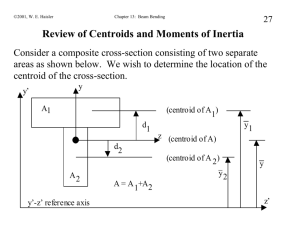advertisement
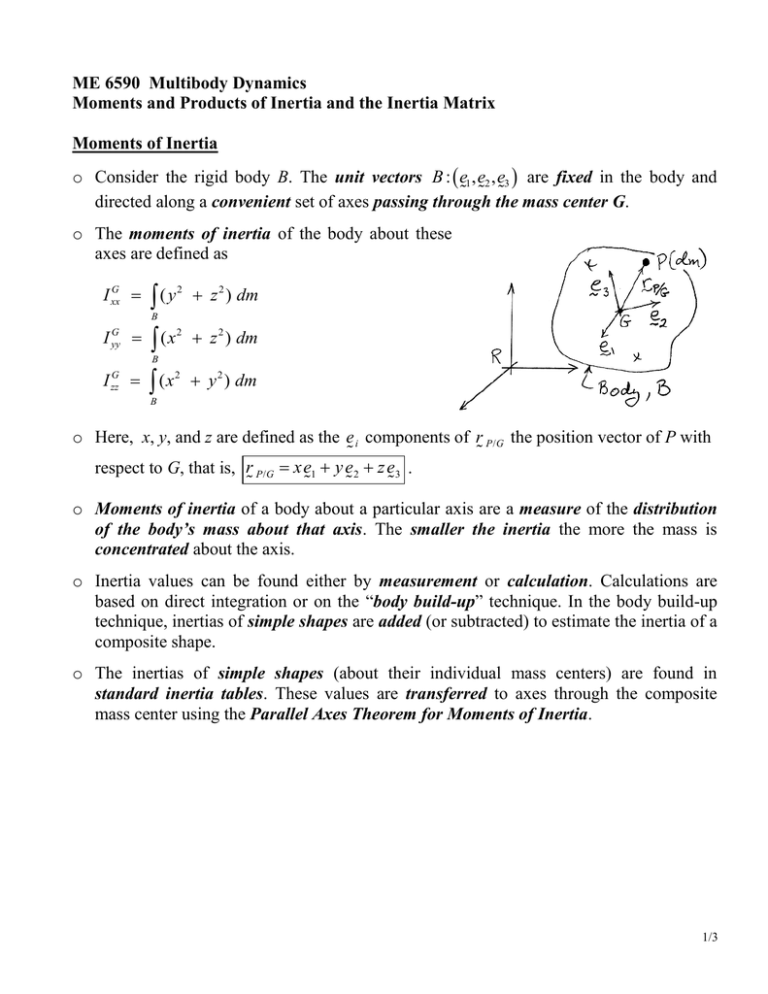
ME 6590 Multibody Dynamics Moments and Products of Inertia and the Inertia Matrix Moments of Inertia o Consider the rigid body B. The unit vectors B : e1, e2 , e3 are fixed in the body and directed along a convenient set of axes passing through the mass center G. o The moments of inertia of the body about these axes are defined as I xxG (y 2 z 2 ) dm 2 z 2 ) dm 2 y 2 ) dm B I G yy I G zz (x B (x B o Here, x, y, and z are defined as the e i components of r P /G the position vector of P with respect to G, that is, r P /G xe1 y e 2 z e3 . o Moments of inertia of a body about a particular axis are a measure of the distribution of the body’s mass about that axis. The smaller the inertia the more the mass is concentrated about the axis. o Inertia values can be found either by measurement or calculation. Calculations are based on direct integration or on the “body build-up” technique. In the body build-up technique, inertias of simple shapes are added (or subtracted) to estimate the inertia of a composite shape. o The inertias of simple shapes (about their individual mass centers) are found in standard inertia tables. These values are transferred to axes through the composite mass center using the Parallel Axes Theorem for Moments of Inertia. 1/3 Parallel Axes Theorem for Moments of Inertia o The inertia ( I iA ) of a body about an axis (i ) through any point ( A) is equal to the inertia ( I iG ) of the body about a parallel axis through the mass center G plus the mass (m) times the distance (di ) between the two axes squared. Or, IiiA IiiG m di2 (i x, y, or z ) o Moments of inertia are always positive. From the parallel axes theorem, it is obvious that the minimum moments of inertia of a body occur about axes that pass through its mass center. Products of Inertia o Products of inertia of the rigid body are defined as I xyG ( xy) dm , B I xzG ( xz) dm , B I yzG ( yz) dm B o Products of inertia of a body are measures of symmetry. o If a particular plane is a plane of symmetry, then the products of inertia associated with any axis perpendicular to that plane are zero. o For example, consider a thin laminate. The mid-plane of the laminate lies in the XY-plane so that half its thickness is above the plane and half is below. Hence, the XY-plane is a plane of symmetry and Thin Laminate I xz I yz 0 o Bodies of revolution have two planes of symmetry. For the configuration shown, the XZ and YZ planes are planes of symmetry. Hence, all products of inertia are zero about the X, Y, and Z axes. Body of Revolution o Products of inertia are found either by measurement or calculation. Calculations are based on direct integration or on the “body build-up” technique. In the body build-up technique, products of inertia of simple shapes are added (or subtracted) to estimate the products of inertia of a composite shape. o The products of inertia of simple shapes (about their individual mass centers) are found in standard inertia tables. These values are transferred to axes through the composite mass center using the Parallel Axes Theorem for Products of Inertia. 2/3 Parallel Axes Theorem for Products of Inertia o The product of inertia ( I ijA ) of a body about a pair of axes (i, j ) passing through any point ( A) is equal to the product of inertia ( I ijG ) of the body about a set of parallel axes through the mass center G plus the mass (m) times the product of the coordinates (ci c j ) of G relative to A measured along those axes. I ijA I ijG mci c j (i, j x, y, or z ) o Products of inertia can be positive, negative, or zero. The Inertia Matrix o The inertias of a body about a set of axes (passing through some point) are often collected into a single inertia matrix. For example, the inertia matrix of a body about a set of axes through its mass center G is defined as I11G IG I 21G I 31G I12G G I 22 I 32G I13G G I 23 G I 33 I xxG G - I xy - I xzG - I xyG I yyG - I yzG - I xzG - I yzG I zzG o There is a different inertia matrix for each set of axes passing through a given point. o There is one set of directions for each point that renders the inertia matrix diagonal. These directions are called principal directions (or principal axes) of the body for that point. In general, the principal axes are different for each point in a body. o All inertia matrices are symmetric. 3/3
